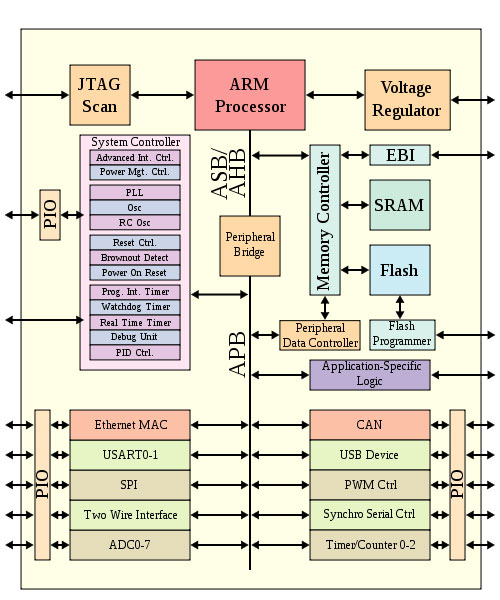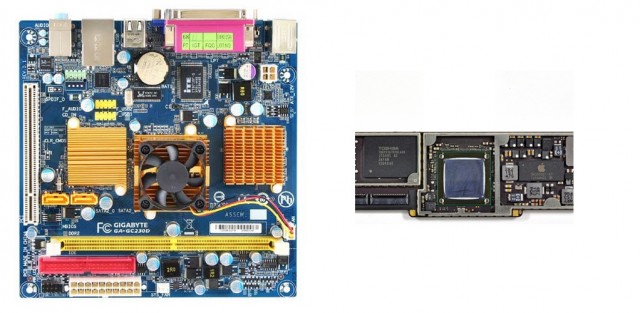
این روزها به مشخصات فنی هر گجتی که سر بزنید نام SoC یا System on a chip به چشم میخورد. با وجود اینکه بارها در مقالات مختلف به شرح مختصر این عبارت پرداختهایم، هنوز بسیاری از کاربران بطور کامل با آن آشنا نیستند و تفاوت آن را با پردازندههای قدیمی نمیدانند. در این مقاله قصد داریم بصورت ساده به تشریح آن بپردازیم. با گجت نيوز همراه باشيد.
CPU چیست؟
CPU یا Central Processor Unit در واقع واحد پردازش اصلی هر کامپیوتر است. کامپیوترها یا ابزارهایی که نیاز به انجام امور محاسباتی دارند، بدون CPU قادر به انجام هیچ کاری نیستند. CPU اطلاعات را از حافظه دریافت نموده، سپس الگورتیمهای مختلف مانند ضرب و جمع یا عملیاتهای منطقی مانند and یا or یا not را برروی آنها اعمال کرده و در نهایت خروجی را تحویل میدهد. هرچه پردازنده قویتر باشد، قادر به پردازش حجم بیشتری از اطلاعات خواهد بود و در نتیجه سرعت سیستم نیز بالاتر خواهد رفت. تمام بخشهای مختلف کامپیوتر به CPU وابسته هستند و بدون آن هیچ عملیاتی انجام نمیشود. اما CPU نیز به تنهایی قادر به فعالیت نیست و به حافظه برای نگهداری اطلاعات، پردازنده گرافیکی برای رندر تصاویر و هزاران قطعه ریز و درشت دیگر نیاز دارد.
SoC چیست؟
سیستم-روی-یک-چیپ یا SoC در واقع یک مدار مجتمع یا IC است که قطعات یک کامپیوتر کامل یا یک سیستم الکتریکی را در یک تراشه جای داده است. SoC ممکن است شامل واحد پردازش مرکزی (CPU)، واحد پردازش گرافیکی (GPU)، حافظه، کنترلرهای ورودی و خروجی مانند USB، مدار کنترل کننده توان، شبکههای بیسیم مانند Wi-Fi، بلوتوث و 4G باشد.

اگر بخواهیم دقیقتر شویم معمولا SoCها شامل بخشهای زیر هستند:
- برخی از SoC ها که دارای چند میکروپروسسور در یک چیپ هستند، MPSoC خوانده میشود؛ این SoCها در واقع از پردازنده چند هستهای بهره میبرند.
- GPU یا واحد پردازش گرافیک
- پردازنده مربوط به رمزگذاری و رمزگشایی تصویر
- حافظه که خود شامل حافظه ROM و RAM و EEPROM میشود
- اینترفیسهای خارجی شامل، کنترلر USB، FireWire، شبکه با سیم، USART و SPI
- اینترفیسهای آنالوگ شامل ADCها و DACها
- رگولاتور ولتاژ و مدار مجتمع کنترل قدرت
- کنترل کنندههای شبکههای بیسیم مانند بلوتوث، وای-فای، 3G یا 4G LTE
پس SoC یک تراشه است که تمام موارد فوق را در خود جای داده و از طریق استاندارد خاصی به یکدیگر متصل نموده است. به عنوان مثال اکثر سیستم-روی-یک-چیپهای امروزی از معماری ARM برای اتصال این قطعات به یکدیگر بهره میبرند. در اغلب SoCها یک کنترلر DMA وظیفه ارتباط بین حافظه و اینترفیسهای خارجی را بدون درگیر کردن هستههای پردازنده بر عهده دارد که به این ترتیب از میزان فشار بر روی پردازنده اصلی در SoC کاسته میشود.
لازم است به این موضوع اشاره کنیم که تمام بخشهای یک SoC توسط یک شرکت طراحی نمیشوند. به عنوان مثال ممکن است تنها CPU و GPU توسط آرم معماری شده و توسط شرکت دیگر تولید شوند. در برخی از SoCها، CPU براساس معماری آرم و GPU یا کنترلرها نیز براساس معماری شرکت دیگری تولید میشوند. تولید کننده این تراشهها نیز برای استفاده از هر کدام از این معماریها باید گواهی مستقل را از صاحبان آنها دریافت کنند. برای کسب اطلاعات بیشتر در این باره به مقاله «معماری ARM چیست؟ چه تفاوتی با x86 اینتل دارد؟ » مراجعه کنید.
تاثیر نرمافزار را فراموش نکنید
هرچند پردازش امور توسط SoC انجام میشود، اما نرمافزار نقش بسیار مهمی را در بازده و عملکرد این پردازندهها ایفا میکند. برای استفاده بهینه و بهرهوری حداکثری از SoCها، نرمافزار و سیستمعاملها نیز باید به خوبی با آنها سازگار شده و از معماری خوبی برخوردار باشند. به عنوان مثال هنوز نرمافزارهای بسیار کمی وجود دارند که قادر به استفاده حداکثری از تمام توان SoCهای چند هستهای هستند.
تفاوت SoC با CPU در چیست؟
در واقع در SoCها، CPU بخشی از تراشه است. مهمترین مزیت SoC و محبوب شدن آنها در سایز بسیار کوچکشان است؛ همان موردی که در تلفنهای هوشمند، تبلتها و دیگر گجتهای قدرتمند امروزی بسیار حائز اهمیت است. به لطف قویتر شدن SoCها، تلفنهای هوشمند امروزی قادر به انجام بسیاری از امور کامپیوترهای شخصی شدهاند.

مزیت دیگر سیستم-روی-یک-چیپها در ارتباط سریعتر و سادهتر بین قطعات مختلف است که منجر به کاهش مصرف انرژی و متقابلا افزایش طول عمر باتری میشود؛ موضوعی که در تلفنهای همراه و گجتهای قابل حمل اهمیت بسیاری دارد.
استفاده از SoCها، هزینه تولید محصول را به میزان قابل ملاحظهای کاهش میدهد؛ چون نیازی نیست که هر کدام از قطعات بصورت جداگانه تولید شده و سپس بصورت مستقل بر روی برد نصب شوند.
مهمترین نقطه ضعف SoCها مربوط به عدم انعطاف پذیری آنها است. در کامپیوترهای شخصی شما به راحتی قادر به تعویض یا ارتقاء GPU یا CPU یا RAM هستید؛ چون این قطعات بصورت مستقل بر روی برد اصلی جای میگیرند. اما در تلفنهای هوشمند امکان ارتقاء این قطعات نیست. شاید در آینده امکان تعویض SoCها در گجتها میسر شود؛ اما در آن صورت نیز باید هزینه بالایی را پرداخت کنید؛ چون در SoC، حافظه رم، پردازنده گرافیکی و دیگر قطعات ذکر شده در بالا، وجود دارند و در این صورت همگی با هم تعویض میشوند.
CPUها به آخر خط رسیدهاند
اما CPUها نفسهای آخر خود را میکشند و هر چه جلوتر میرویم، پردازندهها علاوه بر CPU، بخشهای دیگری از سیستم را نیز در خود جا میدهند. مثلا APUهای AMD یا پردازندههای جدید Core i اینتل علاوه بر CPU دارای GPU داخلی و کنترلرهای حافظه و اسلاتهای PCI Express است. قرارگیری بخشهای مختلف سیستم در یک چیپ باعث ارتباط نزدیکتر، سریعتر و کم مصرفتر آنها شده و در نهایت موجب ارتقاء تواناییهای سیستم میشود. پیش از این GPUها و کنترلرهای حافظه و PCI-E برروی مادربرد قرار میگرفتند و در برخی شرایط ارتباط بین پردازنده و این بخشها با مشکلات ریز و درشتی همراه بود؛ اما در نسل جدید پردازندهها، این مشکلات رفع شدهاند یا به نوعی ارتباط بین آنها تسریع شده است. خوشبختانه در کامپیوترهای مدرن امروزی هرچند GPU در داخل پردازنده اصلی قرار دارد، اما اگر نیاز به قدرت پردازش گرافیکی بیشتری داشته باشید میتوانید از یک کارت گرافیک مستقل با GPU قویتر بهره ببرید و GPU یکپارچه شده با پردازنده را کنار گذاشته یا از آن برای انجام امور ساده استفاده نموده و هر زمان که نیاز به پردازش امور سنگین داشتید، سکان امور را به کارت گرافیک مستقل بسپارید.
منبع : wikipedia
System on a chip
A system on a chip or system on chip (SoC or SOC) is an integrated circuit (IC) that integrates all components of a computer or other electronic system into a single chip. It may contain digital, analog, mixed-signal, and often radio-frequency functions—all on a single chip substrate. A typical application is in the area of embedded systems.
The contrast with a microcontroller is one of degree. Microcontrollers typically have under 100 kB of RAM (often just a few kilobytes) and often really are single-chip-systems, whereas the term SoC is typically used with more powerful processors, capable of running software such as the desktop versions of Windows and Linux, which need external memory chips (flash, RAM) to be useful, and which are used with various external peripherals. In short, for larger systems, the term system on a chip is a hyperbole, indicating technical direction more than reality: increasing chip integration to reduce manufacturing costs and to enable smaller systems. Many interesting systems are too complex to fit on just one chip built with a process optimized for just one of the system's tasks.
When it is not feasible to construct a SoC for a particular application, an alternative is a system in package (SiP) comprising a number of chips in a single package. In large volumes, SoC is believed to be more cost-effective than SiP since it increases the yield of the fabrication and because its packaging is simpler.[1]
Another option, as seen for example in higher end cell phones and on the BeagleBoard, is package on package stacking during board assembly. The SoC chip includes processors and numerous digital peripherals, and comes in a ball grid package with lower and upper connections. The lower balls connect to the board and various peripherals, with the upper balls in a ring holding the memory buses used to access NAND flash and DDR2 RAM. Memory packages could come from multiple vendors.
A typical SoC consists of:
A microcontroller, microprocessor or DSP core(s). Some SoCs—called multiprocessor system on chip (MPSoC)—include more than one processor core.
Memory blocks including a selection of ROM, RAM, EEPROM and flash memory.
Timing sources including oscillators and phase-locked loops.
Peripherals including counter-timers, real-time timers and power-on reset generators.
External interfaces including industry standards such as USB, FireWire, Ethernet, USART, SPI.
Analog interfaces including ADCs and DACs.
Voltage regulators and power management circuits.
These blocks are connected by either a proprietary or industry-standard bus such as the AMBA bus from ARM Holdings. DMA controllers route data directly between external interfaces and memory, bypassing the processor core and thereby increasing the data throughput of the SoC.
Design flow
A SoC consists of both the hardware described above, and the software controlling the microcontroller, microprocessor or DSP cores, peripherals and interfaces. The design flow for a SoC aims to develop this hardware and software in parallel.
Most SoCs are developed from pre-qualified hardware blocks for the hardware elements described above, together with the software drivers that control their operation. Of particular importance are the protocol stacks that drive industry-standard interfaces like USB. The hardware blocks are put together using CAD tools; the software modules are integrated using a software-development environment.
Chips are verified for logical correctness before being sent to foundry. This process is called functional verification and it accounts for a significant portion of the time and energy expended in the chip design life cycle (although the often quoted figure of 70% is probably an exaggeration).[2] With the growing complexity of chips, hardware verification languages like SystemVerilog, SystemC, e, and OpenVera are being used. Bugs found in the verification stage are reported to the designer.
Traditionally, engineers have employed simulation acceleration, emulation and/or an FPGA prototype to verify and debug both hardware and software for SoC designs prior to tapeout. With high capacity and fast compilation time, acceleration and emulation are powerful technologies that provide wide visibility into systems. Both technologies, however, operate slowly, on the order of MHz, which may be significantly slower – up to 100× slower – than the SoC’s operating frequency. Acceleration and emulation boxes are also very large and expensive at $1M+.
FPGA prototypes, in contrast, use FPGAs directly to enable engineers to validate and test at, or close to, a system’s full operating frequency with real-world stimulus. Tools such as Certus[3] are used to insert probes in the FPGA RTL that make signals available for observation. This is used to debug hardware, firmware and software interactions across multiple FPGA with capabilities similar to a logic analyzer.
After debug the hardware of the SoC follows the place-and-route phase of the design of an integrated circuit or ASIC before it is fabricated.
Fabrication
SoCs can be fabricated by several technologies, including:
Full custom
Standard cell
FPGA
SoC designs usually consume less power and have a lower cost and higher reliability than the multi-chip systems that they replace. And with fewer packages in the system, assembly costs are reduced as well.
However, like most VLSI designs, the total cost is higher for one large chip than for the same functionality distributed over several smaller chips, because of lower yields and higher NRE costs.
 گجت نیوز آخرین اخبار تکنولوژی، علم و خودرو
گجت نیوز آخرین اخبار تکنولوژی، علم و خودرو 





